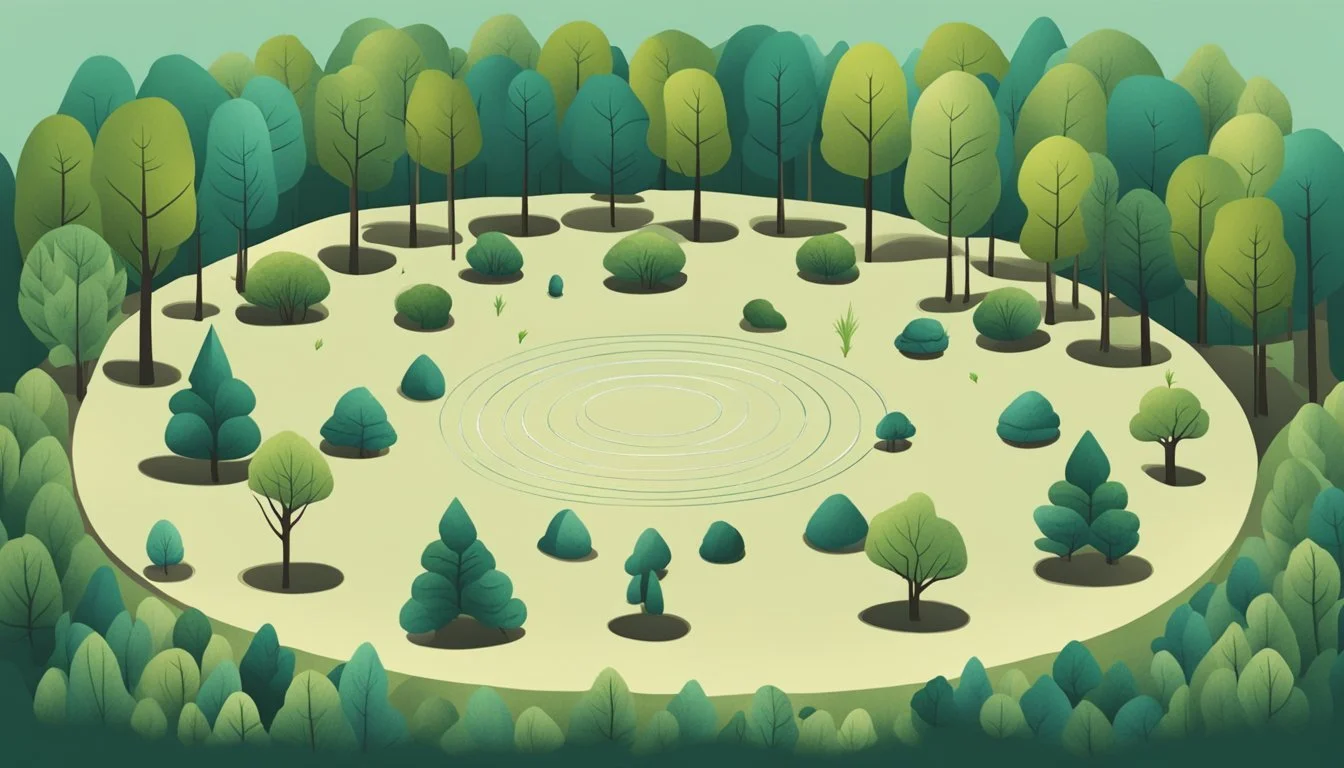13 Grounding Techniques for Managing PTSD-Related Identity Disturbances
Effective Strategies for Stability
Post-Traumatic Stress Disorder (PTSD) can significantly impact one's sense of identity, leading to disturbances that make daily life a challenge. Grounding techniques are strategies aimed to reconnect individuals with their present environment, offering relief from overwhelming PTSD symptoms.
This article explores 13 grounding techniques that can be effective in managing identity disturbances related to PTSD. By implementing these methods, individuals may find a greater sense of stability and normalcy, helping them navigate the complexities of their condition.
1) Deep Breathing Exercises
Deep breathing exercises can significantly alleviate PTSD-related distress. These techniques help regulate the body's response to stress by promoting relaxation and reducing anxiety levels.
One common method is diaphragmatic breathing. It involves taking a slow, deep breath in through the nose while expanding the abdomen, rather than the chest. This type of breathing ensures that the lungs inflate fully, which can help in calming the nervous system.
Box breathing, also known as four-square breathing, is another effective technique. This involves inhaling deeply to a count of four, holding the breath for four seconds, exhaling slowly to another count of four, and then holding the breath again for four seconds before repeating the cycle. This method is simple yet powerful in helping individuals feel more grounded.
Another approach is 4-7-8 breathing. To practice this, a person breathes in quietly through the nose for four seconds, holds the breath for seven seconds, and then exhales completely through the mouth, making a whoosh sound for eight seconds. This controlled breathing pattern can help in managing acute stress effectively.
Each of these techniques focuses on bringing awareness to the breath, which can redirect attention away from distressing thoughts, contributing to a sense of control and calm.
2) Progressive Muscle Relaxation
Progressive Muscle Relaxation (PMR) is an effective technique for managing PTSD-related identity disturbances. It involves tensing and then gradually relaxing different muscle groups in the body.
This method helps in reducing physical tension and fostering a sense of relaxation. Starting with the toes, individuals can focus on tensing and relaxing muscles, working their way up to the head.
Practicing PMR regularly can enhance body awareness and promote calmness. This technique is often recommended by therapists and physicians for managing symptoms of anxiety and stress.
PMR can be easily integrated into daily routines. It is beneficial to practice in a quiet, comfortable space, allowing full attention to the process without distractions.
Progressive Muscle Relaxation is also often paired with deep breathing exercises to further enhance its calming effects.
3) 5-4-3-2-1 Senses Technique
The 5-4-3-2-1 Senses Technique is a grounding exercise designed to anchor individuals in the present moment. It is effective for calming anxiety and managing stress.
This technique involves engaging all five senses: sight, touch, hearing, smell, and taste. The individual is guided to identify specific sensory inputs in a decreasing sequence.
First, they will find 5 things they can see. This can be anything visible around them, from objects to colors.
Next, they identify 4 things they can touch. This helps bring awareness to physical sensations and textures.
Then, they listen for 3 things they can hear. These could be near or distant sounds.
After that, they identify 2 things they can smell. This may include ambient scents, such as flowers or food.
Finally, they focus on 1 thing they can taste. This can include the aftertaste of something they have recently eaten.
This step-by-step method refocuses attention away from distressing thoughts. By concentrating on the present moment, individuals often feel more grounded and calm.
For more detailed guidance on this technique, refer to the 5-4-3-2-1 grounding exercise.
4) Grounding Object Selection
Choosing the right grounding object is crucial for managing PTSD-related identity disturbances. Objects should be small enough to carry easily yet significant enough to prompt immediate sensory engagement.
Items like smooth stones or textured fabric can be effective. They provide a tangible connection to the present moment, helping to anchor the individual when feelings of dissociation arise.
Personal significance can enhance the grounding effect. A meaningful trinket, such as a keychain or piece of jewelry, often offers both sensory and emotional grounding. This dual effect can be particularly stabilizing during episodes of anxiety or disconnection.
Colors and textures should also be considered. Bright, vibrant colors or distinct textures can provide immediate visual or tactile focus, aiding in reorienting attention. Some may prefer objects with a natural element, like a pinecone or leaf.
Switching objects periodically might help maintain their effectiveness. The shift prevents familiarity from dulling the grounding impact. It ensures that the object continues to effectively engage the senses.
Accessibility is key. Keeping the grounding object in a pocket or a designated place ensures it's available when needed. This immediacy offers quick relief, minimizing the delay in managing distressing symptoms.
Selecting the right grounding object is a personal process. What works for one individual may not work for another. Experimentation can help find the most effective object.
5) Positive Affirmations
Positive affirmations can serve as a powerful tool for those managing PTSD-related identity disturbances. Simple, repeated phrases that instill a sense of safety, grounding, and self-worth can make a significant difference.
Using grounding affirmations like "My feet connect me to this moment" or "With every breath, I become more grounded" helps individuals feel more centered and present.
Affirmations can also help counter feelings of guilt or shame often experienced by people with PTSD. Repeating statements such as "I am safe in my own being" or "I am strong, and nothing can shake me" can promote a sense of inner strength and stability.
For those seeking additional positive affirmations, phrases like "I release the past, the future, and find peace in the now" provide support in staying focused on the present moment and leaving behind intrusive thoughts from the past.
Affirmations can be used during daily routines or as part of grounding exercises. Combine these with other techniques like deep breathing to enhance their effectiveness. For example, PositiveRepeats suggests affrmations such as "My feet connect me to this moment" and "With every breath, I become more grounded."
By integrating positive affirmations into daily practices, individuals coping with PTSD can foster a more stable and resilient sense of self.
6) Nature Walks
Nature walks can have a calming effect on individuals experiencing PTSD-related identity disturbances. Engaging with the natural environment helps ground a person in the present moment.
Walking in nature activates the senses. The sound of leaves rustling, birds singing, and the feel of the ground underfoot can direct attention away from intrusive thoughts.
Natural settings provide visual stimuli that can be soothing. Observing the colors of plants, trees, and flowers offers a peaceful distraction, helping to reduce anxiety.
Spending time outdoors also promotes physical exercise. The gentle activity of walking can release endorphins, which are natural mood elevators that help alleviate stress.
Nature walks encourage mindfulness. Focusing on breathing patterns and the rhythm of walking assists in staying present, which is essential for grounding.
Regular walks in green spaces can improve overall mental health. It is beneficial to explore different trails and parks to maintain engagement and curiosity during the practice.
For more information on effective techniques for managing stress and anxiety, consult Grounding Techniques for Coping with PTSD and Anxiety.
7) Sensory Awareness
Sensory awareness involves engaging one's senses to reconnect with the present moment. This technique can be particularly effective for those managing PTSD-related symptoms.
One widely recognized method is the 5-4-3-2-1 exercise. This exercise encourages individuals to focus on five things they can see, four things they can touch, three things they can hear, two things they can smell, and one thing they can taste.
Another approach is to create a sensory toolkit. This toolkit might include items with different textures, scents, or colors that can bring comfort and grounding during moments of distress.
Walking or running outside also helps engage the senses. This activity brings attention to the sounds of nature, the feel of the ground underfoot, and various other sensory inputs.
Stretching can aid in grounding by focusing on how the muscles feel during the activity. Stretching the arms, neck, and legs can relieve tension and promote physical awareness.
Using sensory awareness as a grounding technique helps individuals feel more connected and centered. Simple actions like taking deep breaths or sitting in a new location can also be effective.
8) Guided Imagery
Guided imagery is a powerful tool for managing PTSD-related identity disturbances. This technique involves using detailed and vivid images to focus the mind and soothe the nervous system.
By engaging in guided imagery, individuals can create a mental escape, reducing the intensity of PTSD symptoms. This method encourages the use of positive and serene imagery to counteract negative feelings and thoughts.
Practitioners often use scripts or recordings to help guide individuals through the imagery process. These scripts typically include descriptions of peaceful scenes or empowering visualizations that can help ground the person in a sense of calm and safety.
Clinical studies have shown that guided imagery can help alleviate symptoms such as flashbacks, nightmares, and anxiety. It works by activating the parasympathetic nervous system, promoting relaxation and reducing the body's stress response.
Some common themes used in guided imagery include nature scenes, safe spaces, and personal empowerment scenarios. These themes can be tailored to the individual's preferences and needs, making the practice highly adaptable.
Guided imagery can be practiced alone or with the help of a therapist. The flexibility of this technique makes it accessible and beneficial for those managing PTSD. It provides a mental space for healing and rebuilding a sense of identity disrupted by trauma.
For further details on guided imagery's effectiveness, explore the insights provided by dedicated research on guided imagery for PTSD.
9) Mindfulness Meditation
Mindfulness meditation serves as a valuable tool in managing PTSD-related identity disturbances. It involves focusing one's attention on the present moment, often by observing breath and bodily sensations. This practice helps disrupt negative thought patterns and reduces feelings of anxiety and stress.
Many individuals find that mindfulness-based treatments are effective for PTSD. These treatments encourage present-moment awareness, helping to ground individuals during times of distress. By practicing mindfulness, they can build resilience against intrusive thoughts and emotional upheavals.
In a typical mindfulness meditation session, participants sit quietly and focus on their breathing. When thoughts arise, they are acknowledged without judgment and gently released. This process fosters a sense of calm and stability, crucial for those navigating PTSD symptoms.
Another benefit of mindfulness meditation includes its ease of accessibility. Individuals can practice it anywhere and at any time, making it a versatile grounding technique. Regular practice can enhance emotional regulation and lessen the intensity of PTSD symptoms.
Mindfulness meditation also complements other grounding techniques. It creates a foundation of calm that makes implementing other strategies more effective. Integrating mindfulness into daily routines can help sufferers maintain a continuous state of presence and awareness.
Studies have highlighted the role of mindfulness in improving overall well-being. Engaging in consistent mindfulness meditation can lead to significant improvements in managing PTSD symptoms and enhancing quality of life.
10) Body Scanning
Body scanning is a technique used in meditation and mindfulness practices to bring awareness to various parts of the body.
To perform a body scan, one begins by finding a comfortable position, either sitting or lying down. They then close their eyes and take a few deep breaths to relax.
The process starts at the top of the head. The individual focuses their attention on this area, observing any sensations without judgment.
Gradually, the focus moves down to the forehead, eyes, cheeks, and jaw. Each area is given full attention, noticing any tension or discomfort.
This continues down through the neck, shoulders, and arms, reaching the hands and fingers.
Next, attention shifts to the chest, abdomen, and lower back, feeling each breath and heartbeat.
The scan progresses to the hips, thighs, knees, calves, and ankles.
Finally, the individual concentrates on their feet and toes, noticing the ground beneath them. This helps anchor them to the present moment.
This practice can serve as an effective grounding technique for those managing PTSD-related identity disturbances. Body scanning promotes relaxation and self-awareness, encouraging a deeper connection between the mind and body.
For more information on the body scan technique, please visit Unify Cosmos.
11) Cold Water Splash
Splashing cold water on the face can be an effective grounding technique for managing PTSD-related identity disturbances. The sudden temperature change activates the body's natural dive reflex, which reduces heart rate and promotes calmness.
When an individual feels dissociated or overwhelmed, using cold water to splash their face can help bring them back to the present moment. This technique is straightforward, requiring only access to cold water and a sink or water bottle.
Cold water splash can also be combined with deep breathing exercises. The combination helps regulate breathing patterns and provides a dual sensory experience that reinforces grounding. By focusing on the tactile sensation of water and the rhythmic breathing, the mind is anchored more firmly in the current reality.
For those unable to splash cold water on their face, an alternative is holding a cold object, such as an ice cube, to achieve a similar effect. This can be particularly useful in situations where water is not readily available.
Using cold water splashes can be a discrete and quick method to alleviate dissociation and regain a sense of identity. It does not require any special tools and can be easily incorporated into daily routines.
12) Visualization Techniques
Visualization techniques involve imagining oneself in a safe, calm place or experiencing a positive situation. This can help individuals shift focus from distressing thoughts to more soothing images.
One method is the "safe place" visualization. The person imagines a place where they feel secure and peaceful. This might be a beach, forest, or any place that brings a sense of calm.
Engaging all senses in the visualization can enhance its effectiveness. For instance, if imagining a beach, individuals should focus on the sound of waves, the warmth of the sun, and the scent of saltwater. This immersive experience can divert attention from negative feelings.
Another approach is guided imagery. Resources like recorded scripts or apps can lead individuals through a calming visualization process. Listening to a soothing voice describe a peaceful scene can facilitate relaxation and grounding.
Practicing these techniques regularly can strengthen their impact. Over time, individuals may find it easier to access these calming images when needed, aiding in managing PTSD symptoms. For more information, see various grounding techniques that help with anxiety and PTSD.
13) Yoga and Stretching
Incorporating yoga and stretching exercises can significantly benefit individuals managing PTSD-related identity disturbances. These practices help reduce tension and stress by promoting physical relaxation and mental clarity.
Engaging in yoga and stretching encourages a stronger mind-body connection, which is essential for reclaiming a sense of identity. Yoga practices focused on relaxation and mindfulness techniques provide a calming effect on the nervous system.
Regular yoga sessions, like those outlined in Yoga for Post Traumatic Stress, assist in rewiring the central nervous system to trigger the relaxation response. This method can be customized to fit the needs of various individuals.
Meditative poses and breathing exercises in yoga are particularly useful. Techniques such as deep breathing and gentle stretches help ground a person in the present moment, reducing anxiety and tension.
Studies have shown that yoga is a promising complementary approach to traditional PTSD treatments. It offers a holistic way to manage stress through increased self-awareness and relaxation techniques. This evidence supports the value of yoga in managing PTSD symptoms, making it an effective tool in a comprehensive treatment plan.
Understanding Identity Disturbances
Identity disturbances are marked by significant instability in self-concept and sense of continuity. This can be seen in unpredictable shifts in identity, and a fragmented sense of self.
Definition And Symptoms
Identity disturbances involve a profound disruption in an individual's self-concept. Symptoms often include a fluctuating self-image, feelings of emptiness, and inconsistent values or goals. People may struggle to recognize themselves or feel fragmented, leading to confusion about their true identity. These disturbances can manifest as drastic changes in appearance, opinions, and behavior.
Sufferers might feel as though they are different people at different times. This instability can result in difficulties maintaining relationships, as loved ones may find it challenging to understand these shifts. Intensity and duration of symptoms can vary, making the condition unpredictable and often distressing.
Causes And Contributing Factors
Several factors can contribute to the development of identity disturbances. Traumatic experiences, particularly in childhood, play a significant role. Abuse, neglect, or prolonged stress can disrupt the normal development of a stable identity. This is common in disorders like PTSD and DID.
Psychological theories suggest that identity disturbances may stem from a fragmented self as a defense mechanism against trauma. Genetics and biology can also influence susceptibility. Neurobiological studies indicate that certain brain structures and functions might predispose individuals to identity instability. Moreover, family dynamics, such as lack of validation or constant criticism, can exacerbate these symptoms, making it difficult for individuals to nurture a coherent self-concept.
The Role Of Grounding Techniques In PTSD
Grounding techniques play a crucial role in managing PTSD by helping individuals focus on the present moment and reduce the intensity of traumatic memories. Understanding how these methods work and integrating them into daily life can significantly improve mental well-being.
How Grounding Helps
Grounding techniques assist PTSD sufferers by anchoring them in the present. These strategies divert attention from distressing memories and emotional flashbacks, fostering a sense of physical and emotional safety.
Different methods cater to various sensory experiences. Physical techniques involve tangible activities, such as holding an object or feeling textures. Sensory techniques might include focusing on sounds or smells, helping to redirect the mind from triggering thoughts.
These approaches are vital because they offer immediate and direct ways to manage anxiety. By reducing the power of flashbacks and intrusive memories, grounding techniques help maintain a sense of control.
Integrating Techniques Into Daily Routine
Incorporating grounding techniques into a daily routine enhances their effectiveness. Simple practices, such as starting the day with deep breathing or using a stress ball during work, can make a significant difference.
Daily rituals, like mindful walking or engaging in activities that require full concentration, integrate grounding into everyday life. Scheduled times for grounding exercises can prepare individuals to handle stressful situations better.
By embedding these techniques into routine activities, the likelihood of experiencing their benefits increases. Regular practice ensures that grounding becomes a natural response to stress, providing consistent support and enhancing overall resilience. For further insights, one can explore grounding techniques for PTSD.
Additional Support For Managing PTSD
In addition to grounding techniques, professional therapy options and community resources can significantly contribute to managing PTSD symptoms effectively.
Professional Therapy Options
Therapeutic interventions, such as Cognitive Behavioral Therapy (CBT), play a crucial role in addressing PTSD symptoms. CBT helps individuals recognize and alter negative thought patterns and behaviors.
Eye Movement Desensitization and Reprocessing (EMDR) is another effective method. This technique involves processing traumatic memories while focusing on external stimuli, like side-to-side eye movements.
Medication can also be part of a comprehensive treatment plan. Antidepressants, particularly SSRIs, are often prescribed to manage PTSD symptoms. Consulting with a qualified psychiatrist is essential for this option.
Trauma-focused therapy specifically targets trauma-related emotions and beliefs. Trained therapists guide individuals through techniques that reduce the impact of traumatic experiences.
Support Groups And Community Resources
Support groups offer a communal setting where individuals can share experiences and coping strategies. These groups foster a sense of belonging and reduce isolation.
Organizations like PTSD UK and Talkspace offer resources and facilitate connections between affected individuals. Online platforms can extend these benefits to those unable to attend in-person sessions.
Community centers often provide workshops and seminars, focusing on PTSD management and awareness. These resources can educate both sufferers and their families, improving support systems.
Hotlines and crisis intervention services are crucial for immediate support. They provide access to trained counselors ready to assist during acute episodes of distress.
Integrating these resources into one's life can complement professional therapy, creating a more robust support system for managing PTSD.









